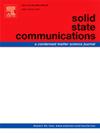Investigating structural and electronic features, band gap modulation, and optical absorption in ASnCl₃ (A = Na, K) perovskites for optoelectronic applications
IF 2.1
4区 物理与天体物理
Q3 PHYSICS, CONDENSED MATTER
引用次数: 0
Abstract
This study uses density functional theory (DFT) within the WIEN2k computational framework to explore the structural, elastic, and optoelectronic properties of cubic perovskite compounds ASnCl₃ (A = Na, K). The findings align well with earlier theoretical and experimental studies, confirming the cubic symmetry and structural stability of both materials. Elastic constants were calculated to verify their mechanical stability, revealing that both compounds are ductile and suitable for practical applications. The electronic band structure analysis shows direct band gaps of 1.462 eV for NaSnCl₃ and 0.825 eV for KSnCl₃, suggesting their potential as efficient semiconductors. These properties make them promising candidates for use in electronic and optoelectronic devices. Additionally, the optical properties were analyzed by calculating the absorption spectra over a photon energy range of 0–10 eV. The results indicate excellent absorption and reflectance characteristics, particularly in the visible and ultraviolet regions. This makes ASnCl₃ (A = Na, K) highly suitable for next-generation solar cells and advanced optoelectronic technologies.
研究用于光电应用的ASnCl₃(A = Na, K)钙钛矿的结构和电子特性、带隙调制和光吸收
本研究在WIEN2k计算框架内使用密度泛函理论(DFT)来探索立方钙钛矿化合物ASnCl₃(A = Na, K)的结构、弹性和光电子性质。研究结果与早期的理论和实验研究很好地吻合,证实了两种材料的立方对称性和结构稳定性。计算了弹性常数来验证它们的机械稳定性,表明这两种化合物都具有延展性,适合实际应用。电子能带结构分析显示,NaSnCl₃的直接带隙为1.462 eV, KSnCl₃的直接带隙为0.825 eV,表明它们有潜力成为高效半导体。这些特性使它们成为电子和光电子器件中有前途的候选者。此外,通过计算光子能量在0-10 eV范围内的吸收光谱来分析其光学性质。结果表明,该材料具有良好的吸收和反射特性,特别是在可见光和紫外区。这使得ASnCl₃(A = Na, K)非常适合用于下一代太阳能电池和先进的光电技术。
本文章由计算机程序翻译,如有差异,请以英文原文为准。
求助全文
约1分钟内获得全文
求助全文
来源期刊

Solid State Communications
物理-物理:凝聚态物理
CiteScore
3.40
自引率
4.80%
发文量
287
审稿时长
51 days
期刊介绍:
Solid State Communications is an international medium for the publication of short communications and original research articles on significant developments in condensed matter science, giving scientists immediate access to important, recently completed work. The journal publishes original experimental and theoretical research on the physical and chemical properties of solids and other condensed systems and also on their preparation. The submission of manuscripts reporting research on the basic physics of materials science and devices, as well as of state-of-the-art microstructures and nanostructures, is encouraged.
A coherent quantitative treatment emphasizing new physics is expected rather than a simple accumulation of experimental data. Consistent with these aims, the short communications should be kept concise and short, usually not longer than six printed pages. The number of figures and tables should also be kept to a minimum. Solid State Communications now also welcomes original research articles without length restrictions.
The Fast-Track section of Solid State Communications is the venue for very rapid publication of short communications on significant developments in condensed matter science. The goal is to offer the broad condensed matter community quick and immediate access to publish recently completed papers in research areas that are rapidly evolving and in which there are developments with great potential impact.
 求助内容:
求助内容: 应助结果提醒方式:
应助结果提醒方式:


